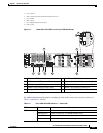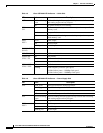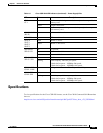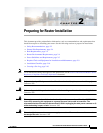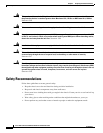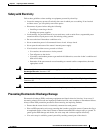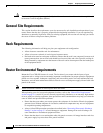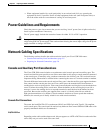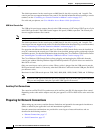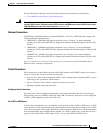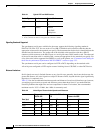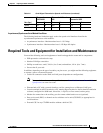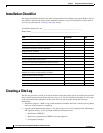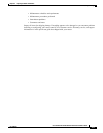
2-5
Cisco 2010 Connected Grid Router Hardware Installation Guide
OL-31454-01
Chapter 2 Preparing for Router Installation
Power Guidelines and Requirements
• When equipment installed in a rack (particularly in an enclosed rack) fails, try operating the
equipment by itself, if possible. Power off other equipment in the rack (and in adjacent racks) to
allow the router under test a maximum of cooling air and clean power.
Power Guidelines and Requirements
Check the power at your site to ensure that you are receiving “clean” power (free of spikes and noise).
Install a power conditioner if necessary.
The AC power supply includes the autoselect feature for either 110 V or 220 V operation.
Caution Two types of power supplies are supported on the Cisco CGR 2010: a low-voltage DC power supply and
a high-voltage DC/AC power supply. Take caution when selecting the correct input voltage for the power
supply installed or damage will result.
Network Cabling Specifications
The following sections describe the cables needed to install your Cisco CGR 2010 router:
• Console and Auxiliary Port Considerations, page 2-5
• Preparing for Network Connections, page 2-6
Console and Auxiliary Port Considerations
The Cisco CGR 2010 router includes an asynchronous serial console port and an auxiliary port. The
console and auxiliary ports provide access to the router either locally using a console terminal connected
to the console port, or remotely using a modem connected to the auxiliary port. This section discusses
important cabling information to consider before connecting the router to a console terminal or modem.
The main difference between the console and auxiliary ports is that the auxiliary port supports hardware
flow control and the console port does not. Flow control paces the transmission of data between a
sending device and a receiving device. Flow control ensures that the receiving device can absorb the data
sent to it before the sending device sends more. When the buffers on the receiving device are full, a
message is sent to the sending device to suspend transmission until the data in the buffers has been
processed. Because the auxiliary port supports flow control, it is ideally suited for use with the
high-speed transmissions of a modem. Console terminals send data at slower speeds than modems;
therefore, the console port is ideally suited for use with console terminals.
Console Port Connections
The router has both EIA/TIA-232 asynchronous (RJ-45) and USB 5-pin mini Type B, 2.0 compliant
serial console ports. The console ports do not have any hardware flow control. Shielded USB cables with
properly terminated shields are recommended.
EIA/TIA-232 Port
Depending on the cable and the adapter used, this port appears as a DTE or DCE device at the end of the
cable. Only one port can be used at the same time.



